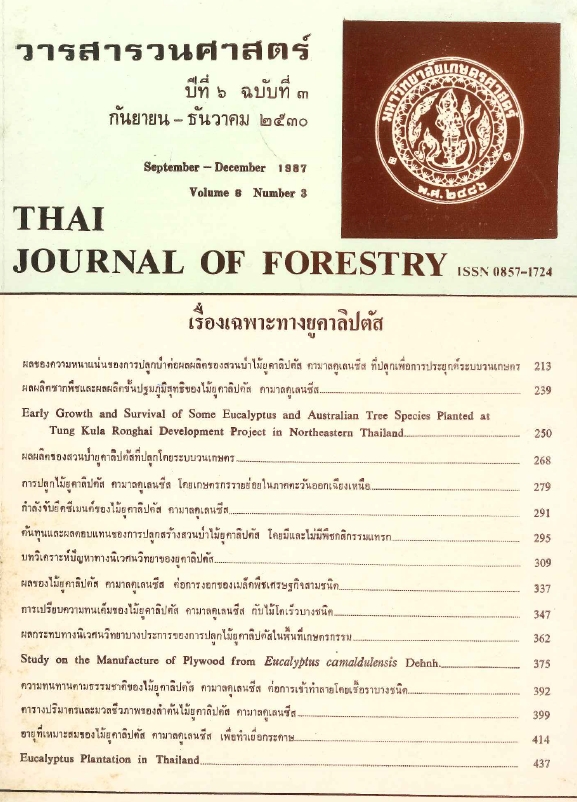ความทนทานตามธรรมชาติของไม้ยูคาลิปตัสคามาลดูเลนซีสต่อการเข้าทำลายโดยเชื้อราบางชนิด
Main Article Content
บทคัดย่อ
ความทนทานตามธรรมชาติของไม้ยูคาลิปตัส เมื่อเปรียบเทียบกับไม้โตเร็ว ๔ ชนิด คือมะฮอกกานีใบใหญ่ นนทรี ตะกู และยางพารา ต่อเชื้อรา white rot และ brown rot ปรากฏว่าไม้ยูคาลิปตัสทำลายได้ดีในจำนวนไม้ทดลองทั้งหมด P. Sangvinevs เป็นเชื้อรา white rot สามารถทำลายไม้ยูคาลิปตัสได้ถึง ๓๖.๖๐% ในขณะที่ทำลายไม้ มะฮอกกานีใบใหญ่ นนทรี ตะกู และยางพาราในระดับ ๒๗.๕๑%, ๑๗.๓%, ๒๗.๕๑% และ ๑๔.๙๒% ตามลำดับ สำหรับ G. Sepiarium เป็น เชื้อรา brown rot เข้าทำลายไม้ยูคาลิปตัสได้ ๔๗.๐๖% ในขณะที่ทำลายไม้มะฮอกกานีใบใหญ่ นนทรี ตะกู และยางพาราได้ ๖.๖%, ๓๒.๔๓%, ๘.๐๕% และ ๔๖.๐% ตามลำดับ อย่างไรก็ตามไม้ยูคาลิปตัสสามารถทนทานต่อการเข้าทำลายโดยเชื้อราบางชนิดได้เช่น Coriolus sp. และ Schisophyllum Commune ทั้งนี้ขึ้นอยู่กับชนิดของเชื้อรา และชนิดของไม้ในการตอบสนองการทำลายไม้
Downloads
Article Details

อนุญาตภายใต้เงื่อนไข Creative Commons Attribution-NonCommercial-NoDerivatives 4.0 International License.
ข้าพเจ้าและผู้เขียนร่วม (ถ้ามี) ขอรับรองว่า ต้นฉบับที่เสนอมานี้ยังไม่เคยได้รับการตีพิมพ์และไม่ได้อยู่ในระหว่างกระบวนการพิจารณาตีพิมพ์ลงในวารสารหรือสิ่งตีพิมพ์อื่นใด ข้าพเจ้าและผู้เขียนร่วม (ถ้ามี) ยอมรับหลักเกณฑ์และเงื่อนไขการพิจารณาต้นฉบับ ทั้งยินยอมให้กองบรรณาธิการมีสิทธิ์พิจารณาและตรวจแก้ต้นฉบับได้ตามที่เห็นสมควร พร้อมนี้ขอมอบลิขสิทธิ์ผลงานที่ได้รับการตีพิมพ์ให้แก่วารสารวนศาสตร์ คณะวนศาสตร์ มหาวิทยาลัยเกษตรศาสตร์ กรณีมีการฟ้องร้องเรื่องการละเมิดลิขสิทธิ์เกี่ยวกับภาพ กราฟ ข้อความส่วนใดส่วนหนึ่ง หรือ ข้อคิดเห็นที่ปรากฏในผลงาน ให้เป็นความรับผิดชอบของข้าพเจ้าและผู้เขียนร่วม (ถ้ามี) แต่เพียงฝ่ายเดียว และหากข้าพเจ้าและผู้เขียนร่วม (ถ้ามี) ประสงค์ถอนบทความในระหว่างกระบวนการพิจารณาของทางวารสาร ข้าพเจ้าและผู้เขียนร่วม (ถ้ามี) ยินดีรับผิดชอบค่าใช้จ่ายทั้งหมดที่เกิดขึ้นในกระบวนการพิจารณาบทความนั้น”


